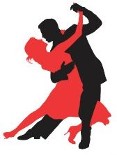|
|
BE ASKED TO DANCE MORE
By Vivian Beiswenger
Reprinted from the November/December2007 issue of Dance Spotlight
Whether you are a lady or a gent, being asked to dance almost always feels good. It feels wonderful to know that someone wants to dance with you – picked you out of the crowd – and it feels even better if he or she comes back for seconds! By surfing the web and through my own experience, I collected a lot of ways to attract more invitations. I wish I could say that I always follow these rules myself, but now that I wrote them down, I am going to try to “walk (dance) like I talk.” Now you can know the secret, too.
1. Dress for Success:
Before you even show up at the dance, prepare for a social activity that involves sharing your personal space with others. Shower, use deodorant and mouthwash, minimize the colognes and perfumes, and pack mints. If offered a mint, consider that there may be a reason, and take one or check your breath. If coming directly from work or a workout, pack toiletries and/or clothing to freshen up before you ask someone to dance. If you are allergic to perfumes, consult a physician, as it will be impossible to eliminate these completely from a social dance unless you are the czar of the dance and can refuse admission. If you perspire profusely, I suggest bringing an extra shirt (or two) to change, if needed. The number one reason why people don’t want to dance with another person is how he/she smells.
2. Smile and make yourself accessible. No one wants to dance with a sourpuss. Leave your problems outside, arrive with a smile on your face, and keep it there throughout the dance. Don’t bring your problems or business to the dance. Greet people and try to remember names, faces, and their special interests. If at all possible, arrive early enough to position yourself near the dance floor and in an accessible position. Don’t hide in the corner or away from the crowd. Look like you want to dance. Tap your foot or hand to the music and watch the other dancers. Make eye contact with potential partners (and make sure that smile is on your face).
3. Say yes when asked. Every “no, thanks” reduces the chance that that person (or someone watching) will ask you again. When you must decline, give a reason (e.g., “don’t know the dance,” “need a break,” “promised this dance to someone else,” etc.). Offer to do the next or a future dance (choose a dance you know and ask for the next one), and then make sure that you are available for that dance. Never refuse a dance and then accept someone else’s offer.
4. On the dance floor: Do not apologize for every mistake. Do not correct your partner or offer help unless asked. Try to make your partner look good. Don’t roll your eyes or smirk (even if your partner can’t see it – other potential partners can and will judge you accordingly). Always ask for your partner’s name (if unknown) and thank your partner for the dance (with a smile and eye contact). Leave the floor with your partner unless one of you is picked up by your next partner.
5. Compliment your partner and other dancers. Try to catch your partner doing something right and acknowledge it. If you admire someone’s dancing, go up to that person/couple (when he and/or she is/are not otherwise occupied) and let him and/or her know. If it’s a couple you are admiring, acknowledge both of them. It takes two to tango. My partner and I always get a chuckle when someone watches us dance and then comes over and raves about one of us. If dancing with a beginner (and especially someone who is improving), encourage him/her (one day he/she may be a great dancer and remember you). Off the floor, don’t critique your partners (those listening, if they are intelligent, will expect the same treatment from you for themselves).
6. When dancing with someone else’s regular partner, be sensitive and respectful to both of them. If you offend or annoy someone’s partner by ignoring him or her or becoming a pest, one or both partners may resent you and make it known to the other, thereby reducing your chances of being asked again.
7. Dance on time and maintain a toned, comfortable frame. Next to your attitude and personal hygiene, these two factors will have the biggest impact on someone wanting to dance with you again. Gentlemen: do your best to dance on time. You may be surprised to know that your repertoire of steps has little to do with someone wanting to dance with you. It’s better to do a few simple steps well, than many fancy steps poorly. Ladies: try to follow his timing – right or wrong. Do not take over the lead or even acknowledge that he is off time. Smile, thank him for the dance and look for a better dancer for the next dance!
Everyone: your dance frame should be light but toned. Use your muscles, not locked joints, to hold a frame. Avoid “spaghetti arms” - limp arms that absorb your partner’s movement rather than match it. Gentlemen: do not pull or push the lady around the floor. If she is having trouble following, simplify your dance routine. Everyone should hold his/her own arms up. Ladies: do not hang on the man. Clasp his hand, but not with a death grip. Allow him to change the hand hold and arm positions easily.
8. Choose the right events and build a network. If you are a single, you might want to avoid going alone to an event where most people are paired. Invite a friend to come with you or better yet invite a group. Too shy to do this? Get over it; in the meantime, there are many groups you can join. There are online meetup groups and dance clubs, plus most studios/teachers sponsor group outings. Join these as often as possible.
9. Continue to improve your dance skills. While this is not the most important factor by far, the better you dance, the more that most people will want to dance with you. Being a good dancer can often counteract failures to follow the preceding items consistently. In addition, you lose what you don’t use. If you stop learning, there is a good chance that your dance skills will decline or get sloppy. The better your dance skills are, the more enjoyment you and your partners will experience.
So, now you know what I’ve learned, but I’d love to hear your opinion. Share your thoughts and experiences. Email me at dancespotlight@blsdc.com and keep on dancing!
About the Author: Vivian Beiswenger, in addition to being the editor of the Delaware Valley Dance Spotlight Newsletter, owns the Ballroom, Latin and Swing Dance Center located in several locations in Montgomery County, PA. She is a former corporate executive and former Senior Vice President of USA Dance. She has organized and chaired many dance competitions including the Delaware Valley Jubilee Championships, several Northeastern Regional Championships, the National Junior, Middle and High School Championships and the 1997 USA DanceSport National Championships (where the US representatives to the World Amateur Championships were selected). She is married to Barry and has one son, Jared - their pride and joy!
|
|











